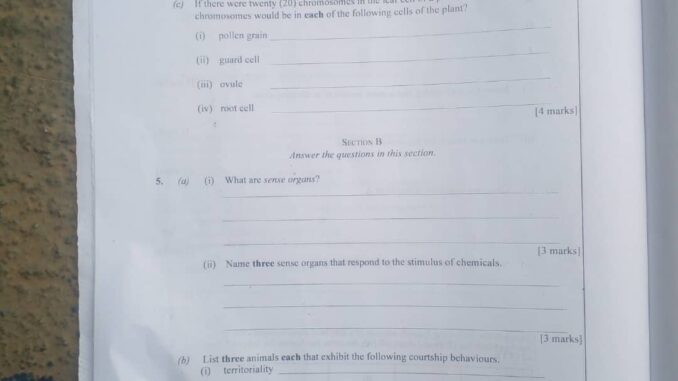
Waec Biology Obj;-ExamgrandComNg !!!!!
01-10:CABADCCBCD
11-20:DBCDDBCBBC
21-30:ADABDAADCD
31-40:BBCBDCBBBA
41-50:ABCCBCACDA
COMPLETED✅
========================================
🙌🙌🙌🙌🙌🙌🙌🙌
Wednesday, 7th June, 2023
Biology 2 (Essay)
▪️9:30am – 11:10am
Biology 1 (Objective)
▪️11:10am – 12:00pm
✅✅✅✅✅✅✅✅✅
========================================
Waec Biology Obj;-ExamgrandComNg !!!!!
=======================================
Waec 2023 Biology Theory;-ExamgrandComNg !!!!!
1a) The classification of living things involves grouping organisms based on their characteristics. The current classification system consists of Domain, Kingdom, Phylum, Class, Order, Family, Genus, and Species.
b)
(i) Fungi
1. Decomposition- Fungi decompose organic matter and recycle nutrients, contributing to soil health.
2. Medicine- Some fungi are used in medicine, such as Penicillium, which produces antibiotics.
3. Food- Edible mushrooms are a popular food item across the world. Certain fungi like yeast are used in baking and fermentation to produce wine and beer.
4. Industry- Fungi are used in industries like paper manufacturing and in the production of enzymes like citric acid and gluconic acid.
(ii) Plants
1. Food- Plants are a major source of food for humans and animals.
2. Oxygen production- Through photosynthesis, green plants produce oxygen which is essential to all living organisms.
3. Raw materials- Fibers are obtained from plants and are used to make clothing, paper, and other products. Plants like timber and bamboo are used for construction purposes.
4. Medicine- Many plants contain compounds with medicinal properties that are used in traditional medicine and pharmaceutical industry.
/OR/
(1)

1c)

=======================================
(2a)
[FILL IN THE TABLE WITH THIS]
IRON:
Function:
(PICK ANY ONE)
-Chlorophyll formation
-Electron transport in photosynthesis
-Enzyme activation
-Nitrogen fixation
Effects of deficiency in plants:
(PICK ANY ONE)
-Chlorosis (yellowing of leaves)
-Stunted growth
-Reduced fruit and seed production
-Interference with nutrient uptake
MOLYBDENUM:
Function:
(PICK ANY ONE)
-Nitrogen fixation
-Enzymatic reactions
-Iron uptake and utilization
-Seed germination and growth
-Chlorophyll formation
Effects of deficiency in plants:
(PICK ANY ONE)
-Reduced nitrogen fixation
-Chlorosis (yellowing of leaves)
-Impaired sulfur metabolism
-Abnormal phosphorus uptake
-Altered enzyme activity
POTASSIUM
Function:
(PICK ANY ONE)
-Osmotic regulation
-Enzyme activation
-Protein synthesis
Effects of deficiency in plants:
(PICK ANY ONE)
-Stunted growth.
-Leaf chlorosis.
-Weak stems.
-Reduced flower and fruit production.
-Increased susceptibility to diseases and pests.
COPPER
Function:
(PICK ANY ONE)
-It plays a vital role in activating various enzymes within plants
-It helps to facilitate photosynthesis
-It helps facilitate respiration in plants
(PICK ANY ONE)
Effects of deficiency in plants:
-Stunted growth
-Yellowing of leaves
-Death of plant tissue
-Reduced fertility
-Increased susceptibility to diseases
NITROGEN
Function:
(PICK ANY ONE)
-It helps in building proteins
-It is a fundamental constituent of nucleic acids and DNA
-It helps in formation of chlorophyll
-It helps in energy transfer and metabolism
-It is an enzyme co-factor
Effects of deficiency in plants:
(PICK ANY ONE)
-Reduced photosynthesis
-Poor protein synthesis
-Leaf necrosis
-Increased susceptibility to diseases and pests.
-Impaired nutrient transport
(2b)
(PICK ANY THREE)
(i) Fruits and Vegetables
(ii) Grains and Cereals
(iii) Legumes and Pulses
(iv) Nuts and Seeds
(v) Dairy Products
(vi) Meat, Poultry, and Fish
(2ci)
BUCCAL CAVITY:
(PICK ANY TWO)
(i) The buccal cavity is the entry point for food and liquids into the digestive system.
(ii) The buccal cavity is responsible for chewing or masticating food.
(iii) The buccal cavity contains salivary glands that produce saliva.
(iv) The buccal cavity plays a vital role in speech production.
(2cii)
DUODENUM
(PICK ANY TWO)
(i) The duodenum receives partially digested food from the stomach and continues the process of digestion.
(ii) The duodenum is involved in the absorption of nutrients from digested food.
(iii) The duodenum plays a role in regulating the overall process of digestion.
(iv) The duodenum secretes several important hormones that regulate various aspects of digestion.
(2ciii)
STOMACH
(PICK ANY TWO)
(i) One of the primary roles of the stomach is to store food temporarily after it has been ingested.
(ii) The stomach aids in the mechanical digestion of food through muscular contractions known as peristalsis.
(iii) The stomach secretes gastric juices, primarily composed of (HCl) and enzymes such as pepsin, which play a crucial role in chemical digestion.
(iv) The stomach controls the rate at which food is released into the small intestine.
(2d)
Glucose and fructose
/OR/
(2)

(2b&c)

(2c)

=======================================
3a) The types of relationships are:
I: Decomposition or saprophytic relationship
II: Commensalism
III: Mutualism
IV: Predation
V: Parasitism
3b) In relationship IV:
– Organism B: Prey
– Organism G: Predator
3c) Examples of organisms B to J
B: Dead tree
C: Vulture
D: Lion
E: Hermit crab
F: Sea anemone
G: Snake
H: Bee
J: Sheep
3d)
(i) The relationship that is most beneficial to the ecosystem is III (Mutualism).
(3dii) One reason for this is that mutualistic relationships involve interactions where both organisms benefit from each other’s presence, contributing to the overall stability and productivity of the ecosystem.
3e)
(I) Examples of organism A:
– Fungi (such as mushrooms or molds) that grow on decaying matter
– Bacteria that decompose organic material
(3eii) The group to which organism A belongs is the decomposers or decomposer organisms.
=======================================
(4)

=======================================
(5ai)
A sense organ is a body part made up of specialized or receptor cells and other tissues which are sensitive to a specific sort of stimulus
(5aii)
(i) Skin
(ii) Tongue
(iii) Eye
(5bi)
(i) Agama lizard
(ii) Male fishes
(iii) birds
(5bii)
(i) Fish
(ii) Toad
(iii) Winged termites
(5ci)
Both eggs are protected by jelly and calcareous shell respectively
(5cii)
TABULATE
EGGS OF TOADS;
(i) Are laid in strings
(ii) Absence of shell
(iii) Presence of jelly around it
EGGS OF BIRDS;
(i) Are laid singly
(ii) Presence of shell
(iii) Absence of jelly
(5d)
TABULATE
ORGANISM INVOLVED IN THE NITROGEN CYCLE;
(i) Nitrosomonas
(ii) Nitrobacter
(iii) Denitrifying bacteria
(iv) Putrefying bacteria
ROLE OF ORGANISM
(i) Convert ammonia to nitrites
(ii) Converts nitrites to nitrates
(iii) Converts nitrates in the soil to atmospheric nitrogen
(iv) Breaks down proteins and organic compounds or nitrates
(5e)
TABULATE
MODES OF HETEROTROPIC NUTRITION;
(i) Holozoic nutrition
(ii) Saprophytic nutrition
EXAMPLES OF ORGANISMS THAT CARRY OUT MODE OF NUTRITION;
(i) Rabbits
(ii) Humans
(iii) Rhizopus
(iv) mushroom.
/OR/
(5b)

(D)

(E)

=======================================
Waec 2023 Biology Questions;-ExamgrandComNg






Completed





Be the first to comment